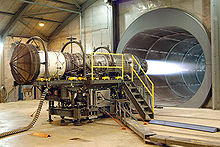Aerospace engineering is the branch of engineering behind the design, construction and science of aircraft and spacecraft.[1] It is broken into two major and overlapping branches: aeronautical engineering and astronautical engineering. The former deals with craft that stay within Earth's atmosphere, and the latter deals with craft that operate outside of Earth's atmosphere.
Aerospace engineering deals with the design, construction, and science behind the forces and physical properties of aircraft, rockets, flying craft, and spacecraft. The field also covers their aerodynamic characteristics and behaviors, airfoil, control surfaces, lift, drag, and other properties. Aerospace engineering is not to be confused with the various other fields of engineering that go into designing these complex craft. For example, the design of aircraftavionics, while certainly part of the system as a whole, would rather be considered electrical engineering, or perhaps computer engineering. The landing gearsystem on an aircraft may fall into the field of mechanical engineering, and so forth. It is typically a large combination of many disciplines that makes up aeronautical engineering.
While aeronautical engineering was the original term, the broader "aerospace" has superseded it in usage, as flight technology advanced to include craft operating in outer space.[2] Aerospace engineering, particularly the astronautics branch, is often informally called "rocket science"
Overview
Flight vehicles undergo severe conditions such as differences in atmospheric pressure, and temperature, with structural loads applied upon vehicle components. Consequently, they are usually the products of various technological and engineering disciplines including aerodynamics, propulsion, avionics,materials science, structural analysis and manufacturing. These technologies are collectively known as aerospace engineering. Because of the complexity of the field, aerospace engineering is conducted by a team of engineers, each specializing in their own branches of science.[5]
The development and manufacturing of a modern flight vehicle is an extremely complex process and demands careful balance and compromise between abilities, design, available technology and costs. Aerospace engineers design, test, and supervise the manufacture of aircraft, spacecraft, and missiles. Aerospace engineers develop new technologies for use in aviation, defense systems, and space exploration.
Elements
See also: List of aerospace engineering topics
- Fluid mechanics – the study of fluid flow around objects. Specifically aerodynamics concerning the flow of air over bodies such as wings or through objects such aswind tunnels (see also lift and aeronautics).
- Astrodynamics – the study of orbital mechanics including prediction of orbital elements when given a select few variables. While few schools in the United States teach this at the undergraduate level, several have graduate programs covering this topic (usually in conjunction with the Physics department of said college or university).
- Statics and Dynamics (engineering mechanics) – the study of movement, forces, moments in mechanical systems.
- Mathematics – in particular, calculus, differential equations, and linear algebra.
- Electrotechnology – the study of electronics within engineering.
- Propulsion – the energy to move a vehicle through the air (or in outer space) is provided by internal combustion engines, jet engines and turbomachinery, or rockets(see also propeller and spacecraft propulsion). A more recent addition to this module is electric propulsion and ion propulsion.
- Control engineering – the study of mathematical modeling of the dynamic behavior of systems and designing them, usually using feedback signals, so that their dynamic behavior is desirable (stable, without large excursions, with minimum error). This applies to the dynamic behavior of aircraft, spacecraft, propulsion systems, and subsystems that exist on aerospace vehicles.
- Aircraft structures – design of the physical configuration of the craft to withstand the forces encountered during flight. Aerospace engineering aims to keep structures lightweight.
- Materials science – related to structures, aerospace engineering also studies the materials of which the aerospace structures are to be built. New materials with very specific properties are invented, or existing ones are modified to improve their performance.
- Solid mechanics – Closely related to material science is solid mechanics which deals with stress and strain analysis of the components of the vehicle. Nowadays there are several Finite Element programs such as MSC Patran/Nastran which aid engineers in the analytical process.
- Aeroelasticity – the interaction of aerodynamic forces and structural flexibility, potentially causing flutter, divergence, etc.
- Avionics – the design and programming of computer systems on board an aircraft or spacecraft and the simulation of systems.
- Software – the specification, design, development, test, and implementation of computer software for aerospace applications, including flight software, ground control software, test & evaluation software, etc.
- Risk and reliability – the study of risk and reliability assessment techniques and the mathematics involved in the quantitative methods.
- Noise control – the study of the mechanics of sound transfer.
- Flight test – designing and executing flight test programs in order to gather and analyze performance and handling qualities data in order to determine if an aircraft meets its design and performance goals and certification requirements.
The basis of most of these elements lies in theoretical mathematics, such as fluid dynamics for aerodynamics or the equations of motion for flight dynamics. There is also a large empirical component. Historically, this empirical component was derived from testing of scale models and prototypes, either in wind tunnels or in the free atmosphere. More recently, advances in computing have enabled the use of computational fluid dynamics to simulate the behavior of fluid, reducing time and expense spent on wind-tunnel testing.
Additionally, aerospace engineering addresses the integration of all components that constitute an aerospace vehicle (subsystems including power, aerospace bearings, communications, thermal control, life support, etc.) and its life cycle (design, temperature, pressure, radiation, velocity, lifetime).



0 comments:
Post a Comment